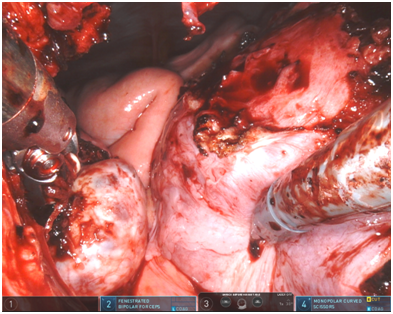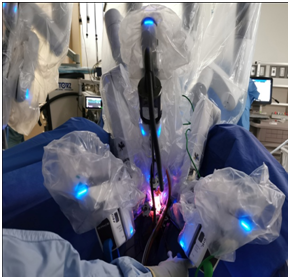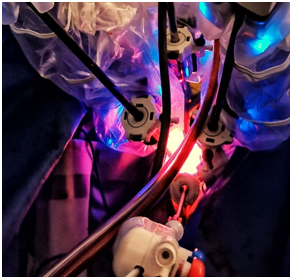eISSN: 2377-4304


Case Report Volume 10 Issue 4
1Division of Minimally Invasive Gynecologic Surgery, Department of Obstetrics and Gynecology, Baylor College of Medicine, USA
2Department of Family Medicine, University of Alabama, USA
3School of Medicine, University of Alabama at Birmingham (UAB), USA
4Department of Obstetrics and Gynecology, Maternal and Fetal Medicine, Lincoln Medical and Mental Health Center, USA
5The Third Affiliated Hospital of Guangzhou Medical University, China
Correspondence: Xiaoming Guan MD PhD, Section Chief and Fellowship Director, Division of Minimally Invasive Gynecologic Surgery (MIGS), Department of Obstetrics and Gynecology, Baylor College of Medicine, 6651 Main Street, 10th Floor, Houston, Texas, 77030, USA, Tel (832) 826-7464, Fax (832) 825-9349
Received: June 26, 2019 | Published: August 7, 2019
Citation: Rezai SMD, Giovane RAMD, Johnson SNBS, et al. Robotic natural orifice transluminal endoscopic surgery (R-NOTES) in gynecologic surgeries, a case report and review of literature. Obstet Gynecol Int J. 2019;10(4):287-289. DOI: 10.15406/ogij.2019.10.00456
Background: Natural Orifice Transluminal Endoscopic Surgery (NOTES) involves accessing the abdominal cavity through a natural orifice. It provides easier access for the surgeon; has a reduced recovery times and decreases postoperative pain
Objective: To present an initial experience with robotic natural orifice transluminal surgery (R-NOTES) in gynecology using the da Vinci surgical system.
Case: We present a case of a 40 year old, Asian female, Gravida 2- Para 1-0-1-1 with irregular, heavy menstrual cycle, abnormal uterine bleeding due to uterine leiomyoma (AUB-L) who under went Da Vinci Natural Orifice Transluminal Endoscopic Surgery (NOTES), total Laparoscopic hysterectomy (TLH), bilateral salpingectomy (BS), Lysis of adhesions (LOA), and cystoscopy. The patient had uncomplicated recovery and postoperative care and was discharged on postoperative day zero.
Conclusion: Robotic NOTES Total laparoscopic hysterectomy with bilateral salpingectomy is feasible and safe in gynecology patient. This approach has the potential for a less morbid and scarless outcome.
Keywords: da vinci; minimally invasive surgery, natural orifice transluminal endoscopic surgery, robotic NOTES, robotic natural orifice transluminal surgery, single port laparoscopy
MIS, minimally invasive surgery; NOTES, natural orifice transluminal endoscopic surgery; R-NOTES, robotic natural orifice transluminal surgery; SPL, single port laparoscopy; AUB-L, abnormal uterine bleeding due to uterine leiomyoma; TLH, total Laparoscopic hysterectomy; BS, bilateral salpingectomy; LOA, lysis of adhesions
Natural Orifice Transluminal Endoscopic Surgery (NOTES) involves accessing the abdominal cavity via a natural orifice.1 Through NOTES, less tissue is manipulated such as in the case of laparotomy or laparoscopy and with this, it would decrease recovery times as well as have less scaring.1 With NOTES being a new technique, success on it relies on the surgeon’s comfort level as well as evolving technology to makes this technique easier.2
We present a case of a 40-year-old female, Gravida 2, Para 1-0-1-1, who referred to our clinic for definitive surgical management of dysmenorrhea, irregular heavy menses, pelvic pain, abnormal uterine bleeding secondary to uterine leiomyoma (AUB-L), refractory to medical and conservative surgical management. Her other surgical history is pertinent for a cesarean section and laparoscopic myomectomy. Pelvic exam revealed a 12cm retroflexed mobile fibroid uterus.
Pelvic ultrasound showed enlarged leiomyomatous uterus with multiple uterine fibroids, the largest being 4cm.
Patient underwent Da Vinci Natural Orifice Transluminal Endoscopic Surgery (NOTES), total Laparoscopic hysterectomy (TLH), bilateral salpingectomy (BS), Lysis of adhesions (LOA), and cystoscopy (Figures 1–3).

Figure 1 Performing hysterectomy, Arm 2: fenestrated bipolar grasper, Arm 3: camera, Arm 4: monopolar curved scissors.
GelPOINT mini was placed in the vagina and the Da Vinci XI was docked as following arrangement (Figure 1) (Figure 4):


Figure 4 robotic arms setup: Arm 2: fenestrated bipolar grasper, Arm 3: camera, Arm 4: Monopolar curved scissors, 5mm air seal used as accessory port, GelPOINT mini in place.
Natural Orifice Transluminal Endoscopic Surgery (NOTES) is a technique that uses a natural orifice such as the mouth, anus or vagina in order to access the abdominal cavity. It was first performed by Rao and Reddy in 2006 for an appendectomy3 and since then it has been implemented in other surgeries such as gastric and vaginal. Since natural orifices are used, less scarring has been documented as well as less post-operative pain.1,4 The use of robotic assistance, such as the Da Vinci machine can aid in dexterity and precision of the surgical process.5
Although NOTES has strengths it does have draw backs. Thus far, the safest NOTES route is transvaginally due to enteral closure.1 A draw back to this is that it would only benefit female patients. Furthermore, as this technique is new, it is reliant on advances in medical equipment to make this technique easier and more feasible. As there is only one access port, instruments must be positioned properly and multi-tasking can be difficult.6
Robotic NOTES Total laparoscopic hysterectomy with bilateral salpingectomy is feasible and safe in gynecology patient. This approach has the potential for a less morbid and scarless outcome. Further development of robots adaptive to NOTES would boost efforts toward clinical NOTES applications.
Dr. Xiaoming Guan is a speaker for Applied Medical, Rancho Santa Margarita, California.
Other authors did not report any potential conflicts of interests.

©2019 Rezai, et al. This is an open access article distributed under the terms of the, which permits unrestricted use, distribution, and build upon your work non-commercially.